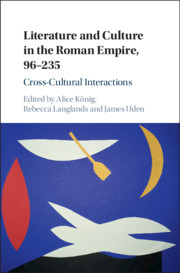Book contents
- Literature and Culture in the Roman Empire, 96–235
- Literature and Culture in the Roman Empire, 96–235
- Copyright page
- Contents
- Figures
- Contributors
- Preface
- Timeline
- Abbreviations
- Map
- Introduction
- Part I Refiguring Roman and Greek Interactions
- Part II Imperial Infrastructure: Documents and Monuments
- Chapter 7 Constructing a New Imperial Paradoxography
- Chapter 8 A Formation of a Christian Archive?
- Chapter 9 Keeping/Losing Records, Keeping/Losing Faith
- Chapter 10 Shaping Buildings into Stories
- Chapter 11 Architectural Criticism in the Roman World and the Limits of Literary Interaction
- Chapter 12 Dying for Justice
- Part III Cultural Translation and Transformation
- References
- Index
Chapter 8 - A Formation of a Christian Archive?
The Case of Justin Martyr and an Imperial Rescript
from Part II - Imperial Infrastructure: Documents and Monuments
Published online by Cambridge University Press: 28 April 2020
- Literature and Culture in the Roman Empire, 96–235
- Literature and Culture in the Roman Empire, 96–235
- Copyright page
- Contents
- Figures
- Contributors
- Preface
- Timeline
- Abbreviations
- Map
- Introduction
- Part I Refiguring Roman and Greek Interactions
- Part II Imperial Infrastructure: Documents and Monuments
- Chapter 7 Constructing a New Imperial Paradoxography
- Chapter 8 A Formation of a Christian Archive?
- Chapter 9 Keeping/Losing Records, Keeping/Losing Faith
- Chapter 10 Shaping Buildings into Stories
- Chapter 11 Architectural Criticism in the Roman World and the Limits of Literary Interaction
- Chapter 12 Dying for Justice
- Part III Cultural Translation and Transformation
- References
- Index
Summary
Justin Martyr’s Apologies cite an imperial letter. Scholarly debate has usually focused on whether this letter is real. This chapter argues instead that the rescript associated with Justin’s Apologies, and the Apologies themselves, evoked known cultural and adminstrative practices – practices of hanging papyrus libelli and their subscriptiones in Rome at the Temple of Apollo or the Baths of Trajan, practices also known from the ‘publication’ of rescripts epigraphically in cities far from Rome. Justin’s rescript was thus made real in part through engagement with broader practices of documents in the built environment of cities. The reference to an imperial letter shows Christian citation and/or imitation of imperial documents, a practice that fits within a larger, shared culture of composition, collation, and publication of local complaint and imperial response. An investigation of the rescript associated with Justin provides a focal point to consider larger issues: how minoritized groups in antiquity responded to Roman imperial power, how political power was experienced in urban spaces, and how legal(ish) documents, whether real or invented, could be used to assert rights and resistance.
Keywords
- Type
- Chapter
- Information
- Literature and Culture in the Roman Empire, 96–235Cross-Cultural Interactions, pp. 179 - 202Publisher: Cambridge University PressPrint publication year: 2020

